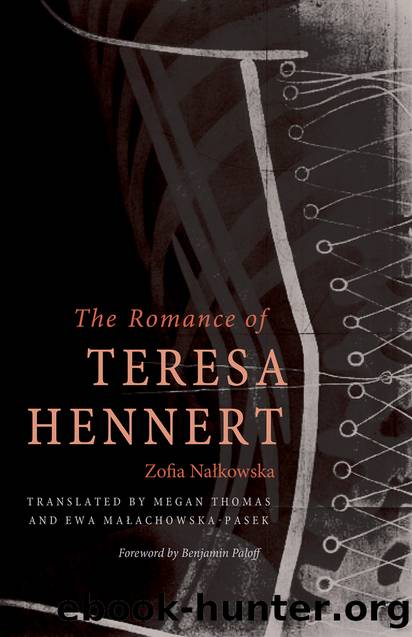The Romance of Teresa Hennert by Nalkowska Zofia;Thomas Megan;Malachowska-Pasek Ewa;Paloff Benjamin;

Author:Nalkowska, Zofia;Thomas, Megan;Malachowska-Pasek, Ewa;Paloff, Benjamin;
Language: eng
Format: epub
Publisher: Cornell University Press
Published: 2014-10-24T00:00:00+00:00
Notes
1. filet (Fr.): An old style of embroidery in which a pattern is worked by hand into fine netting.
2. new settlements for soldiers: In December 1920, the Polish Sejm approved two acts that would allow demobilized soldiers of the Polish Army to apply for plots of land in the Kresy (Borderlands), which had been ceded to the new Republic at the end of the Polish-Soviet War. A major aim of the program was to polonize the area, including western portions of modern-day Ukraine and Belarus. Poorly managed and underfunded from the beginning, the program was suspended in 1923.
3. Sheâs from the Borderlands.: The Polish Kresy, or Borderlands, encompass those territories east of present-day Poland that belonged to the Polish-Lithuanian Commonwealth before it was partitioned by its neighbors in the late eighteenth century, and that includes large portions of Lithuania, western Belarus, and western Ukraine. Although the negotiations that established an independent Poland in 1918 did not include these territories within the new stateâs eastern border, they were ceded to Poland following its 1921 victory in the Polish-Soviet War.
4. aged Marcelain: A brand of cognac prized in the late nineteenth and early twentieth centuries.
5. two bottles of Chambertin: A fine French red wine from around the village of Gevrey-Chambertin, in Burgundy.
6. most recent enemy attack on the northern Borderlands: Poland annexed the Lithuanian capital of Vilnius and its surrounding area between 1920 and 1922 through means both military and political. Consequently, diplomatic relations between the two states were not normalized until 1938.
7. Each case in its own right would be sufficient as casus belli.: From 1919 to 1922, several regional and international incidents reflected ongoing tensions between the new Polish state and its neighbors and ethnic minorities, who disputed its borders.
8. Shortly thereafter he was imprisoned for illegal educational activities and then sent into exile.: Poland under partition (1795â1918) saw sharp restrictions on cultural and educational activities regarded by the partitioning powers as fostering Polandâs ambitions toward self-determination. This was especially the case in the Prussian and Russian partitions. Those who ran afoul of the Russian authorities, particularly in cultural centers like Warsaw, could be arrested and sent into Siberian exile. Laternaâs âillegal educational activitiesâ may have included offering instruction in Polish, which was legal in the Russian partition only after 1905.
9. she fell victim to the first wartime epidemic: The 1918â1920 influenza pandemic, commonly known as the âSpanish flu,â killed an estimated 20 to 50 million people, more than World War I itself.
10. a certain old palace: Ewa Wiegandt points out in her annotations to the Biblioteka Narodowa edition of Romans Teresy Hennert that NaÅkowskaâs model for the âcertain old palaceâ was the Namiestnikowski Palaceâtoday, the Presidential Palaceâin central Warsaw, where NaÅkowska worked in the Office of Foreign Propaganda. Zofia NaÅkowska, Romans Teresy Hennert, ed. Ewa Wiegandt (WrocÅaw: Ossolineum, 2001), 34.
11. Biedermeier chairs: âBiedermeierâ refers to a range of functional, neoclassical furniture designs developed in Germany during the first half of the nineteenth century. Here, it demonstrates the taste and elegance of the officeâs décor.
Download
This site does not store any files on its server. We only index and link to content provided by other sites. Please contact the content providers to delete copyright contents if any and email us, we'll remove relevant links or contents immediately.
Room 212 by Kate Stewart(4739)
The Crown by Robert Lacey(4572)
Endurance: Shackleton's Incredible Voyage by Alfred Lansing(4506)
The Iron Duke by The Iron Duke(4122)
The Rape of Nanking by Iris Chang(4023)
Killing England by Bill O'Reilly(3897)
Joan of Arc by Mary Gordon(3782)
Say Nothing by Patrick Radden Keefe(3725)
I'll Give You the Sun by Jandy Nelson(3273)
Shadow of Night by Deborah Harkness(3174)
Hitler's Monsters by Eric Kurlander(3164)
Mary, Queen of Scots, and the Murder of Lord Darnley by Alison Weir(3064)
Blood and Sand by Alex Von Tunzelmann(3055)
Darkest Hour by Anthony McCarten(3018)
Margaret Thatcher: The Autobiography by Thatcher Margaret(2971)
Eleanor & Park by Rainbow Rowell(2943)
Red Famine: Stalin's War on Ukraine by Anne Applebaum(2816)
Book of Life by Deborah Harkness(2719)
The One Memory of Flora Banks by Emily Barr(2684)
